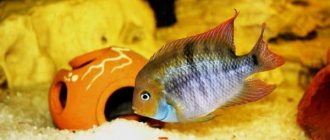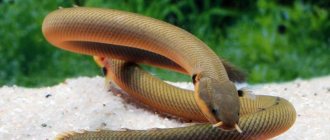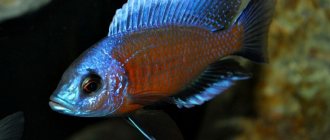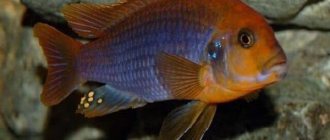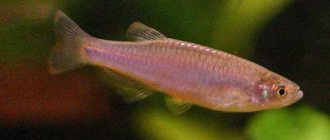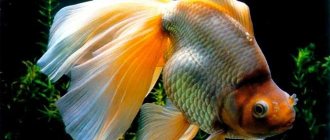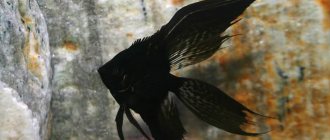Citron or lemon cichlid is one of the most beautiful cichlids in Central America. Aquarists love it for its bright color, unusual appearance, and large size. There are legends about the nature of lemon cichlazoma. In America it is known as the “red devil” - Red devil cichlid. The debate about the taxonomic identity of this species continued for more than 30 years. And even experienced aquarists still confuse lemon cichlas with another species of cichlas (Amphilophus labiatus). Confusion is also created by the fact that citron cichlid is sold under the name Midas cichlid.
Origin and habitat
European aquarists first became acquainted with citron cichlasoma in 1970. It was discovered in the San Juan River (Nicaragua, Costa Rica) and adjacent bodies of water, including the large tectonic lake of Managua. Lemon cichlid lives in small lakes formed in the craters of extinct volcanoes.
It was first described in 1864 by the famous zoologist, ichthyologist and herpetologist Albert Gunther. It was often confused with Amphilophus labiatus or the big-lipped cichlasoma due to its similar appearance and habitat. Only at the end of the twentieth century was it proven that these two species have different structures of nuclear and mitochondrial DNA. The Amphilophus citrinellus species complex includes about 10 subspecies. Until recently, only 9 of them were described and studied.
In the wild, lemon cichlids can have a variety of colors, from gray to olive brown with the vertical stripes characteristic of cichlids. There are also representatives of pink, white, yellow or orange.
Bright coloring and pronounced fatty growth are a product of selection and can appear in the wild only during certain periods of the fish’s life. Enlarged lips may occur in wild individuals. Researchers believe that this phenomenon is associated with the food preferences of wild cichlids, and is absent in aquarium specimens.
The lemon cichlid continues to expand its habitat. She has already mastered the southeast of America - Florida. The fish, brought to Asia, has adapted to live even in the brackish waters of Singapore.
Description
Citron cichlid, also known as lemon cichlid and midas cichlid (Latin Amphilophus citrinellus, formerly Cichlasoma citrinellum, English Midas Cichlid) is a large fish of the cichlid family, attracting many aquarists with its bright color, size and unusual head shape. It comes from Central America: it inhabits the San Juan River basin, lakes of Nicaragua and Managua, and reservoirs of Costa Rica. They live in places with slow or no currents at all; they prefer rocky shores and embankments, among which they search for food.
This species is often confused with Amphilophus labiatus, also known as the red devil, which is extremely similar to the citron cichlasoma, but differs from it in smaller dimensions (citron cichlasoma: 30-35 cm, labiatus: up to 28 cm), as well as genetic differences and local habitat: Labiatus are endemic, living exclusively in the Lake Nicaragua basin, while lemon cichlids are more common in the waters of Central America. Despite minor differences, the red devil and lemon cichlasoma form pairs well and interbreed in an aquarium, which makes it difficult to determine the species of the offspring.
Citron cichlazomas have a very specific appearance: it is believed that dominant males, as they grow older and reach puberty, develop a fatty lump on their forehead, but such a neoplasm has been observed more than once in females, especially older ones. Based on the results of numerous observations, it has been established that if a dominant individual with a wen is placed in another aquarium, this growth will appear in another male in the original aquarium, as a replacement for the first one. In nature, these frontal tubercles appear only during the spawning period, but in aquarium conditions they can develop permanently in various individuals, which is part of the mechanism of adaptation to confined space conditions.
In the aquarium hobby you can find a lot of different color variations of citron cichlasoma, including white and spotted. They are bred through selection, and the natural color of lemon cichlid varies from golden yellow to bright orange. It is believed that such popular fish as the flowerhorn and the three-hybrid parrot were bred with her participation.
- Male citrons, as a rule, are larger than females: they can reach a length of up to 30 cm, while females can reach up to 20 cm. Most likely, in captivity, the dimensions of both sexes will be smaller.
- Another distinctive feature is the depressed frontal line above the eyes in males. In females it is not so clearly expressed.
- Another difference is the different shapes of the dorsal and anal fin: in males they are more elongated, thinner and thread-like, while in females they are wider and rounded.
- But the main sexual characteristics, of course, appear during the spawning period. In males, a cone-shaped spermatic canal begins to protrude, and in females, an expanding trapezoidal ovipositor begins to protrude.
Adults and juveniles differ significantly from each other in color: young ones have scales of gray-yellow, grayish-blue shades of varying saturation - from pale to dark.
The average lifespan of citron cichlazoma is 10-12 years. Many of them can live up to 17 years under optimal conditions.
Appearance
In the wild, citron cichlazoma reaches a significant size - 30-35 cm in males and 20-25 cm in females. In an aquarium their size is much smaller. Life expectancy in nature is 15-17 years. With proper care and nutrition in an aquarium, a fish can live more than 10 years.
The body of the fish is quite massive, flattened laterally, and high. The large head with large eyes and thick lips has a depression that runs above the eye line. The protruding forehead increases with age due to the growing formation - the “wen”. In alpha males, the fat formation is larger than in ordinary males. If the dominant male is removed from the aquarium, then another male will take his place, and over time his “wen” will acquire an impressive size.
The terminal or middle mouth of the citron cichlazoma is determined by the type of feeding. She hunts in the middle layers of water. This arrangement of the oral fissure is characterized by the same size of the upper and lower jaws.
Juvenile and adult specimens are so distinctly different in appearance and color that an inexperienced amateur may mistake them for different species. In juveniles, the background body color varies from gray to olive blue. Dark vertical stripes are visible on the sides, and a dark spot is located in the center of the lateral surface of the body.
The adult is more brightly colored. The background color can vary from light yellow to orange. Some have dark spots on their fins and sides. Lemon cichlasomas have pronounced sexual dimorphism:
| Characteristic | Males | Females |
| Body size | more | less |
| Fatty growth | expressed | less noticeable |
| Depression above the eye line | more noticeable | less noticeable |
| Dorsal and anal fins | pulled out into a “braid” | round shape |
During the spawning period, the male is easily distinguished by his elongated and pointed vas deferens. Females have an ovipositor in the shape of a truncated pyramid with a wide base.
Sexual maturity is reached at the age of 9-15 months.
Some aquarists note that males “mature” earlier than their partners, which can present some difficulties in breeding since the fish mate at an early age.
Compatibility with other fish
Since the citron cichlid is an aggressive fish, it will exhibit predatory behavior even in a large aquarium with a volume of 600-700 liters. Therefore, it is recommended to keep them with fish of the same species or cichlids of different species.
Compatible
Here are some recommended companions: big catfish, Astronotus, Blue Dempsey, Meeka cichlasoma, Managua cichlasoma, Turquoise acara. However, make sure your lemon cichlid is well fed to avoid any loss to other fish.
Not compatible
Citron cichlazomas pose a great threat to peaceful, small fish, shrimp, crabs, snails, semi-aggressive fish and plants.
Keeping in an aquarium
Lemon cichlid is a hardy fish that can live for a long time in an aquarium if it is provided with acceptable conditions. Representatives of this breed are territorial fish that require at least 100 liters, and for a pair - 200-300 liters. Such a large space is necessary due to the fact that fish:
- in an aquarium they grow up to 20-30 cm, and for comfort they need space;
- fiercely defend their territory. The larger the aquarium, the less aggressive the “red devil” behaves;
- During the spawning period, the male attacks competitors and even females; in order to zone the aquarium and arrange shelters in it, a lot of space is needed.
In a small volume, the “red devil” will not only fully show its fighting ardor, but can also destroy the composition of the pool and break the equipment. Therefore, all devices - filters, heater, lighting devices - must be placed outside the container. Cichlids tend to jump out of the aquarium; to prevent the death of the fish, it is necessary to bury the container with a lid.
Cichlazomas are quite demanding regarding the characteristics of the aquatic environment. Since the fish lives in areas with a warm climate, the comfortable water temperature for it is 22-26°C. Sudden changes in temperature negatively affect the condition of the “red devil”.
A decrease in temperature below 15° can lead to the death of the fish.
A heater with a regulator is a must-have equipment for an aquarium with cichlids.
In addition, the water must meet the following indicators:
- hardness – no more than 10-12° (medium);
- pH value – pH-6.5-7.5;
- lighting – moderate;
- aeration and filtration are required;
- weekly replacement - 20-30% of the volume.
To provide dim lighting, you can use fluorescent lamps with a power of 0.5 W/l. Large fish leave a huge amount of waste products that poison the environment and change its characteristics. Powerful filters and an aeration system should be a mandatory component of the equipment for a reservoir with citrons.
Fish do not like strong currents, so the aeration system may include powerful compressors. “Foreign” cichlids are equipped with special pumps. The main thing is that the equipment does not make loud noise and ensures sufficient oxygen saturation of a large volume of the home pool.
Selection of soil and plants
Large, active cichlids love to dig the soil, making shelters for themselves, and tearing out plants with a weak root system. To keep the water in the aquarium clear, it is better to use granite chips, medium and large river pebbles, and coarse sand as soil. Plants do not feel very comfortable in such a substrate.
If you choose how to decorate an aquarium with cichlids, then you need to choose plants with a powerful root system and bite-resistant, hard leaves:
- Echinodorus;
- cryptocorynes;
- Vallisneria;
- Anubias.
It is better to plant large plants around the perimeter of the container, leaving enough space in the center for large fish to swim. Another way out to protect plants from damage by citron cichlisoma is to place them in pots hidden under the ground. Plants floating on the surface of the water will provide the shade the fish need and will not be dug up.
Since cichlids love various shelters, grottoes, and snags, you can use unpretentious plants such as Thai or Indian fern, Java moss, and cladophora to decorate them. In addition to wide possibilities in creating an aquascape, these plants are unpretentious, tolerate shading, and do not require feeding. But their main quality is the ability to purify water from organic matter, which is completely useful when breeding such large fish.
Some aquarists advise using artificial plants for decoration or not using landscaping at all, so as not to bother with spoiled plants.
Zoning and landscape creation
To ensure a comfortable existence for fish, it is necessary to zone the reservoir using planting. Green “screens” will create separate areas measuring 40x40 cm per individual. Grottoes, stone piles, driftwood or decorative elements located at the bottom will allow the fish to hide from aggressive relatives. On the periphery - near the walls, you need to place several flat stones for laying eggs.
Description of the family
The cichlid family (lat. Cichlidae) belongs to the order Perciformes. There are about 200 species inhabiting the waters of Africa, Central and South America, and even in Southeast Asia there are 2 species. They mostly prefer fresh water, but some species can live in salted water.
Most members of the family have a tall body, slightly flattened laterally. The head is large relative to the body, the mouth has well-defined lips; in males, with age, a fatty growth appears on the forehead.
Mostly monogamous, they choose one partner and remain faithful to him for the rest of their lives. The spawning substrate can be varied: a flat pebble, a trench, a plant leaf. Some fish hatch eggs in their mouths. Males of these cichlids have rounded spots on their anal fin. When the female pecks the spawned eggs for further incubation in her mouth, she tries to grab a spot on the anal fin of the gentleman, mistaking it for an egg, prompting the male to release milk into the oral cavity with the eggs.
Fertility is different for everyone:
- large cichlazomas can spawn about 2000 eggs;
- small fish that carry eggs in their mouths, no more than 100 eggs.
Cichlids are characterized by caring for their offspring; they protect and wash the eggs and larvae with their fins, and bite into food for the fry. As a rule, both parents care for the brood. The first eggs released are usually eaten, but subsequent eggs are hatched normally. If producers periodically eat caviar, then you can place the substrate with the eggs in a separate container, and allow aeration underneath.
They vary in whimsicality:
- Some cichlids, such as blackstripe and meeka, can be suitable even for beginners, you just need to provide them with enough space.
- But cichlids such as discus, apistogramma, and nannakars, on the contrary, require certain knowledge and experience from their owner.
They are not selective in feeding, and for the most part are predators, but there are species with a mixed diet or even herbivores. All types of dry, live and frozen food can be used as food:
- tubifex;
- coretra;
- shellless shrimp;
- pieces of sea fish.
Herbivorous species and species with mixed nutrition can be fed:
- cucumber;
- food with the addition of spirulina algae;
- zucchini;
- carrot;
- spinach;
- scalded cabbage and lettuce leaves.
The behavior of cichlid fish is quite interesting, each individual has an individual character. Some cichlid breeders note that their pets are able to distinguish their owner from a stranger, “beg” for food, and sometimes even greet them home from work. But, unfortunately, their interesting and complex nature gives rise to a lot of problems - most of them are aggressive territorial fish, in nature capable of attacking predators many times their size. Aggression especially increases during spawning, so it is advisable to provide new parents with a living space separate from their neighbors.
Bullying can be stopped by raising different types of cichlid fish together from juvenile age, providing sufficient aquarium volumes and a large number of necessary shelters and grottoes.
An exception:
- apistograms,
- discus,
- angelfish.
Nutrition
Citron cichlid is a predatory fish. For proper nutrition, she needs protein foods. In the wild, fish are found in bodies of water with an abundance of snails, small fish, insects and their larvae. In the aquarium they enjoy eating fresh and frozen protein food:
- enchitraeum;
- coretra;
- tubifex;
- gammarus;
- bloodworm;
- artemia;
- small pieces of fillet of sea fish, crustaceans, mollusks;
- lean beef, scraped.
Beef can be given no more than once a week. Mammalian protein is poorly absorbed by cichlazoma and can cause obesity in it. Plant foods provide the body with vitamins and fiber. Scalded pieces of zucchini, cabbage leaves, lettuce, and dandelions will be used as herbal supplements to the diet.
They also feed cichlases with special dry food for large cichlids with spirulina and carotenoids, which support the bright colors of the fish. They produce dry food in the form of granules, flakes, and pellets.
Live worms and caterpillars are an excellent addition to the diet. They are indispensable during the spawning period, as they ensure the production of healthy eggs and stimulate reproduction. But you cannot overfeed cichlase worms - they contain a lot of protein. It is enough to give worms once a week.
You need to feed the fish 2-3 times a day in small portions so that leftover food does not contaminate the soil.
Aquarists advise using automatic feeders that will dispense clearly measured portions of food at certain intervals. Overfeeding is fraught with serious pathologies.
Breeding
Cichlids begin to reproduce when they reach 1 year and a length of about 10 cm.
The best way to breed fish is to purchase 6 juveniles (3 males and 3 females) and raise them together, allowing pairs to form naturally. As soon as a dominant pair is formed, it is advisable to remove other fish from them; for their own safety, the pair will defend the territory for their future offspring.
The stimulus for spawning is an increase in temperature to 26-28 ° C, regular water changes and plentiful feeding of high-protein live or frozen food.
The pre-spawning period can last from a couple of weeks to six months. At this time, citrons circle in front of each other with their fins widely spaced and their mouths open - this is a kind of mating game. During this period, the fat lump in both of them increases noticeably.
The male can often be aggressive towards the female and can even beat her to death due to limited movement space or because she swam too close to the area he has chosen for spawning.
To prevent this from happening, it is worth placing small shelters for the female in the form of decorative structures at the bottom of the aquarium so that she can squeeze into them, but the male cannot. Many aquarists place a separation net between them for several weeks so that the male can get used to his partner.
Editorial: Gambusia
When the spawners start digging, they are ready to spawn and most likely the netting can be removed. However, make sure that the male does not attack the female, then you will have to put the separator back.
There are no guarantees that even such measures will help; many aquarists do not remove the separator between individuals at all during spawning. They drill small holes in it to allow the male to fertilize the eggs without sharing a common space with the female.
After the male prepares the spawning site, the female lays up to 2000 eggs in it (depending on the conditions of detention, spawning ground, nutrition of the individuals and their health), and the male fertilizes these eggs. The parents eat the remaining unfertilized eggs.
The incubation period is 1-3 days, after which the fry are transferred by their parents to places in the ground dug for them. Within 5-7 days they become capable of independent swimming.
From this point on, it will be advisable to place a divider between the male and female. It is especially not recommended to place fry during this period: the male may try to carry out a second spawning, but the female will not be ready for it. In this case, he may well beat her to death in a fit of aggression.
Notes
- In the first days, the fry's food is the secretion produced by the skin glands of the parents; then it is recommended to feed them with microscopic crustaceans and ciliates.
- To prevent large fry from eating smaller ones, they can be sorted from each other by size.
- Under favorable conditions, their growth and development occur rapidly, and the color changes from gray to other shades approximately when the fry reach a length of 2-2.5 cm.
- Cichlazoma meeka and red devil are able to mate with citron cichlazoma and produce hybrid forms. If you do not want this to happen, you should not keep them in the same aquarium.
Diseases
If the characteristics of water, temperature, or nutrition are violated, the likelihood of citron cichlase disease increases. These fish are very susceptible to a severe invasive disease - hexamitosis. As a result of pathology, erosions and areas of depigmentation appear on the lateral line of the body. Ulcers and abscesses form on the head. Therefore, the disease is also called “hole disease.”
The cause of infection can be the abuse of offal and meat of warm-blooded animals. Also factors of hole disease are:
- non-compliance with diet;
- monotonous food;
- vitamin deficiency caused by a lack of vitamins C and B;
- high levels of nitrates;
- acidic pH of water.
Cryptobiosis is also found in American cichlids. Symptoms of the disease are:
- fading and darkening of body color;
- “bulging” eyes and blindness;
- loss of appetite;
- loss of mobility.
As a result, the fish die.
Decor
The cichlid acquires a special charm thanks to the massive decorative elements. The basis of the design is the rock formations that form the background. The cichlid should have plenty of shelters and caves. The aesthetic accent of the aquarium is driftwood. They come in two types. Branched models look good in a vertical position, so that the upper cut extends beyond the water surface. Compact driftwood perfectly complements the bottom in a horizontal position. Cichlid inhabitants are very sensitive to change, so rearrangements and design updates are highly undesirable.
Reproduction
Aquarists advise placing 5-6 fry of both sexes in an aquarium. While they are growing, pairs are formed. A pair is formed very early - in juvenile age. Fish that do not have a mate are removed. A problem in breeding may be the female's later puberty.
It is better to place a pair ready for spawning in a spacious spawning tank. During this period, males often behave aggressively. In a small container, it can even attack a female, especially if she accidentally swims into the place that the male has chosen to lay eggs.
The male carefully selects and prepares a place for spawning. Since cichlids lay eggs on the substrate, you need to put a flat stone, a piece of clay plate, or aquarium glass. The female lays about 2000 eggs on this surface. Their number depends on the size and age of the female.
Swimming over the clutch, the male fertilizes the eggs. Often after fertilization, the male begins to bite the fins of females and “beat” them. Aquarists involved in breeding “red devils” advise using perforated fish tank dividers or special spawning boxes.
Both parents care for the clutch - guarding, turning over and sorting the eggs. After a few days, fry are born, which the fish transfer to pre-prepared holes in the soil or shelters. From the moment of hatching until independence, babies feed on a special secretion that is synthesized by glands on the sides of their parents.
When the fry begin to swim independently, they are fed with starter food consisting of:
- nauplii;
- Artemia;
- small crustaceans.
To prevent smaller individuals from becoming food for their larger counterparts, they must be periodically sorted by size and placed in a separate container.
Citron cichlid is not the easiest fish to keep, but its beauty completely pays for the investment of time, effort, and money.
Breeding
Provided you can get a compatible pair, breeding is quite simple. By far the best way to pair up is to buy at least six young fish and raise them together. The fish become sexually mature when they reach 15-18 cm in length.
Requirements for the spawning tank
To create favorable conditions for reproduction, follow a few simple requirements:
- set the temperature at 27-29°C;
- hardness – 10-12 dGH;
- create a pH environment at 6.8-7.0;
- take care of flat surfaces for laying eggs: these can be pieces of old plates or tiles.
Breeding procedure
- The spawning ritual begins with the two fish swimming in circles around each other and slapping their tail fins sideways with their mouths wide open. It can last from 2 weeks to 6 months before they are mated.
- Be aware that during this ritual the male may become aggressive towards the female. In some cases, an aquarium divider may be necessary to protect the woman if the man is too violent.
- The female lays eggs on a flat surface, and then the male fertilizes them. After 2-5 days the eggs will hatch. The female is capable of laying 1000 eggs at a time, so her abdomen greatly increases in size.
- Their parental care is excellent, as both sexes care for the eggs and defend their territory from everyone else.
- The parents then move the fry to a pre-dug hole in the substrate, and after 5-7 days the fry will be free to swim.
- They grow very quickly under the right conditions. Initially they are grayish in color and size about 5-6 centimeters.
